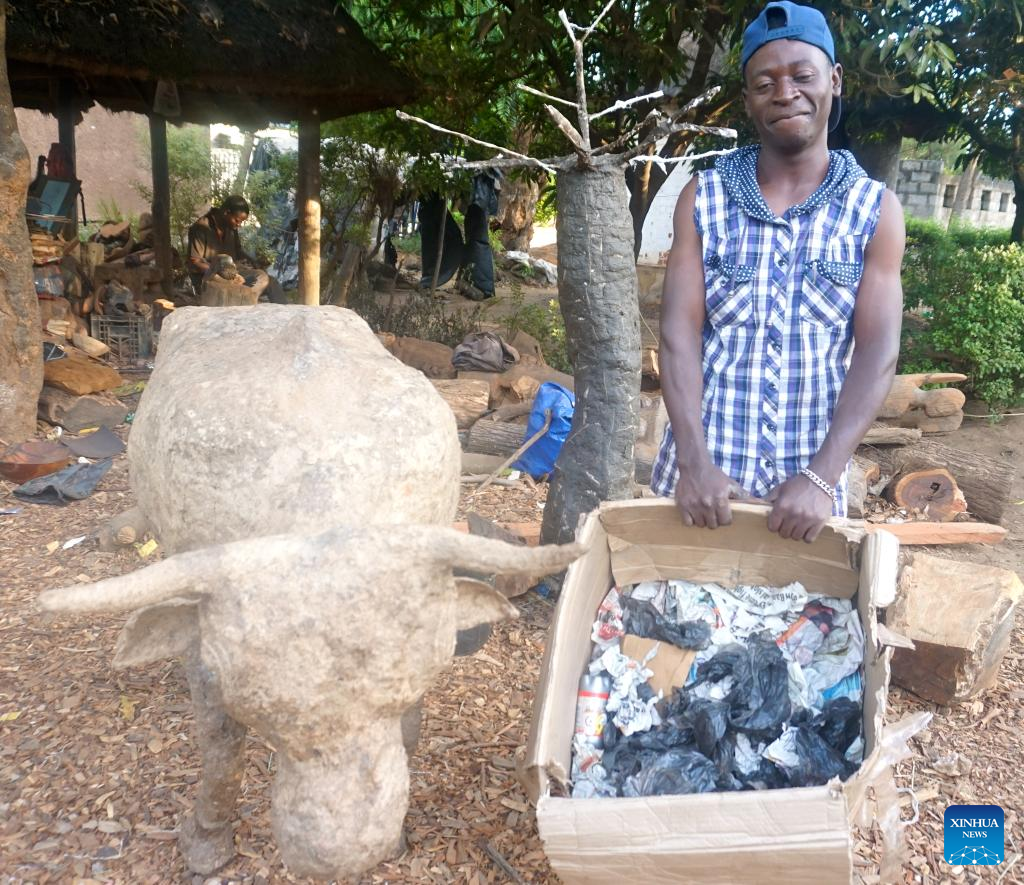
A handicraft maker gets a discarded piece of wood to use for making curios at Kabwata Cultural Village in Lusaka, Zambia, on April 15, 2023. In Zambia, handicrafts such as curios and carvings have for a long time been made from wood derived from different tree types. However, climate change and its effects are pushing some handicraft makers to embrace sustainable handicraft-making methods. (Photo by Lillian Banda/Xinhua)
LUSAKA, April 26 (Xinhua) -- In Zambia, handicrafts such as curios and carvings have for a long time been made from wood derived from different tree types. However, climate change and its effects are pushing some handicraft makers to embrace sustainable handicraft-making methods.
A visit to Kabwata Cultural Village, a national heritage site located in Lusaka, the capital of Zambia, revealed that some handicraft makers are now using recyclable plastic waste and paper. Some other handicraft makers are using discarded logs to make crafts instead of cutting down fresh trees.
According to Kabwata Cultural Village Chairperson Masiye Mubita, handicraft makers are now trying to limit the cutting down of trees for the purposes of making curios and other art-based items.
Mubita said ongoing climate change sensitization programs organized by Kabwata Cultural Village are helping raise awareness about the effects of deforestation among handicraft makers.
"The programs aim to encourage them (handicrafts makers) to explore environmentally friendly ways of making crafts. Handicraft makers are being encouraged to use trees that have fallen down as a result of heavy rains or other natural occurrences instead of cutting down fresh ones," he said.
Mubita said that about 300 handicraft makers from Kabwata Cultural Village have participated in climate change adaptation programs that encourage tree planting and the use of fast-growing tree species such as Jacaranda to make curios and other woodcarvings.
"The Jacaranda tree takes about five years to grow and mature into a tree that can be used for carvings. That means that it can be planted and harvested for artworks and other usages, leaving other tree species to continue covering forest areas," he added.
A curio maker, Henry Siabbaba, who trades at Kabwata Cultural Village, noted that participating in climate change programs has helped him be innovative and keep up with modern trends.
"I am now able to make new curios from old discarded artifacts made from wood," said Siabbaba, 57, who has over 20 years of experience in curio making.
He observed that a good number of tourists and arts and culture enthusiasts are happy to purchase handicrafts made in an environmentally sustainable way, a sign that people are more than ready to support businesses that protect the environment.
Siabbaba's sentiments on recycling were echoed by 24-year-old Anthony Tembo who specializes in making life-size ornamental objects using old newspapers and recyclable plastic bags and bottles.
Tembo, one of the youngest handicraft makers at Kabwata Cultural Village, said using recyclable materials to make crafts helps rid the environment of waste and creates income opportunities.
"In my case, resources for making artworks are almost readily available and cost little to nothing. All I have to do is collect recyclable plastic items and paper," said Tembo. ■

Artist Anthony Tembo stands next to a life-size bull he made using old newspapers and plastic materials in Lusaka, Zambia, on April 15, 2023. In Zambia, handicrafts such as curios and carvings have for a long time been made from wood derived from different tree types. However, climate change and its effects are pushing some handicraft makers to embrace sustainable handicraft-making methods. (Photo by Lillian Banda/Xinhua)
